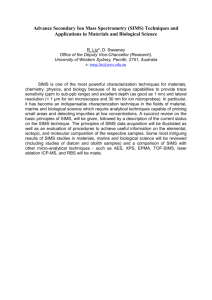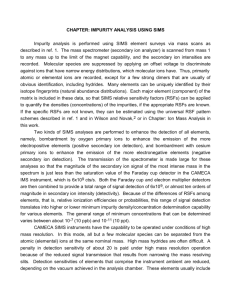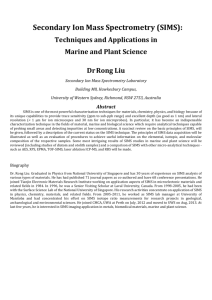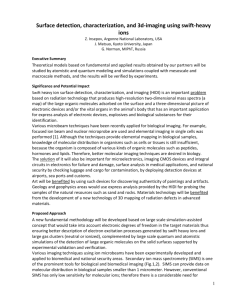SIMS – Secondary Ion Mass Spectrometry
advertisement
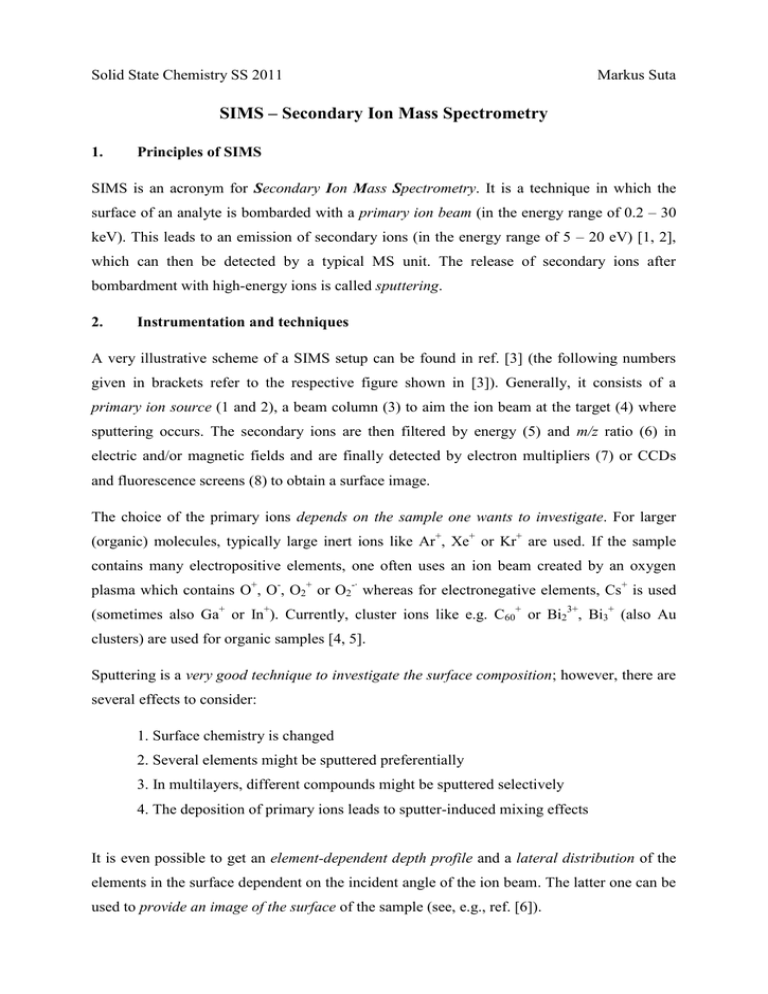
Solid State Chemistry SS 2011 Markus Suta SIMS – Secondary Ion Mass Spectrometry 1. Principles of SIMS SIMS is an acronym for Secondary Ion Mass Spectrometry. It is a technique in which the surface of an analyte is bombarded with a primary ion beam (in the energy range of 0.2 – 30 keV). This leads to an emission of secondary ions (in the energy range of 5 – 20 eV) [1, 2], which can then be detected by a typical MS unit. The release of secondary ions after bombardment with high-energy ions is called sputtering. 2. Instrumentation and techniques A very illustrative scheme of a SIMS setup can be found in ref. [3] (the following numbers given in brackets refer to the respective figure shown in [3]). Generally, it consists of a primary ion source (1 and 2), a beam column (3) to aim the ion beam at the target (4) where sputtering occurs. The secondary ions are then filtered by energy (5) and m/z ratio (6) in electric and/or magnetic fields and are finally detected by electron multipliers (7) or CCDs and fluorescence screens (8) to obtain a surface image. The choice of the primary ions depends on the sample one wants to investigate. For larger (organic) molecules, typically large inert ions like Ar+, Xe+ or Kr+ are used. If the sample contains many electropositive elements, one often uses an ion beam created by an oxygen plasma which contains O+, O-, O2+ or O2-∙ whereas for electronegative elements, Cs+ is used (sometimes also Ga+ or In+). Currently, cluster ions like e.g. C60+ or Bi23+, Bi3+ (also Au clusters) are used for organic samples [4, 5]. Sputtering is a very good technique to investigate the surface composition; however, there are several effects to consider: 1. Surface chemistry is changed 2. Several elements might be sputtered preferentially 3. In multilayers, different compounds might be sputtered selectively 4. The deposition of primary ions leads to sputter-induced mixing effects It is even possible to get an element-dependent depth profile and a lateral distribution of the elements in the surface dependent on the incident angle of the ion beam. The latter one can be used to provide an image of the surface of the sample (see, e.g., ref. [6]). 3. The two modes of operation in SIMS There are two main methods in SIMS: Static SIMS and dynamic SIMS. In static SIMS, a pulsed primary ion beam is used and ultrahigh vacuum conditions are needed. This method is used to get information about the top monolayer of a sample, for thin samples and organic material. In dynamic SIMS, a constant ion beam of high sputtering rate is used and only moderate vacuum conditions are needed. It is mainly used for the detection of trace impurities in samples, e.g. in semiconductors and also for the depth profiling of elements in samples. 4. Applications of SIMS, Advantages and Disadvantages SIMS is generally used for the analysis of surfaces; however, it can also be used for the bulk analysis of solids. Main applications are the trace detection in semiconductors, analysis and depth profiling of thin layers or the imaging of surfaces. The strength in SIMS lies in the fact that all elements can be analyzed, isotopes can be distinguished, the large detection limit (which lies in the ng/g or ppb range) and the imaging of lateral distributions. On the other hand, however, mass spectra in SIMS might get very complex, the reference material must be very similar to the sample to be investigated and sputter yields are highly dependent on chemical composition of the sample. 5. Literature [1] J. H. Gross, Mass Spectrometry – A Textbook (2nd ed.) 2011, Springer Verlag, Heidelberg. [2] J.-M. Mermet, M. Otto, M. Valcárcel, R. A. Kellner, H. M. Widmer, Analytical Chemistry (2nd ed.) 2004, Wiley, Weinheim. [3] http://en.wikipedia.org/wiki/Secondary_ion_mass_spectrometry (12.06.2011) [4] D. Weibel et al., Anal. Chem. 2003, 75, 1754. [5] G. Nagy, A. V. Walker, Int. J. Mass Spectrom. 2007, 262, 144. [6] A. Brunelle, O. Laprevote, Anal. Bioanal. Chem. 2009, 393, 31. [7] V. T. Cherepin, Secondary Ion Mass Spectroscopy of Solid Surfaces 1987, VNU Science Press, Utrecht.
